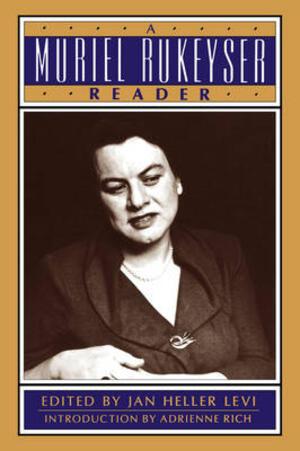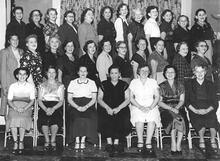Muriel Rukeyser
Muriel Rukeyser published her first book of poetry, Theory of Flight, in 1935, at age twenty-one; it won her the Yale Younger Poets Award. Rukeyser was a passionate activist: she was arrested while covering the second Scottsboro trial for a student newspaper, was present at hearings on a West Virginia silicon mining disaster, witnessed the beginning of the Spanish Civil War in 1936, saw the opening of the Golden Gate Bridge, and worked at the graphics division of the Office of War Information. She later taught at Sarah Lawrence College, traveled to Hanoi on an unofficial peace mission, and was arrested for protesting the Vietnam War. She was elected president of PEN in 1975 and traveled to Korea to protest the incarceration of poet Kim Chi-Ha.
Overview and Early Life
To be a Jew in the twentieth century
Is to be offered a gift. If you refuse,
Wishing to be invisible, you choose
Death of the spirit ...
Accepting, take full life.
Muriel Rukeyser’s poetry faces the challenge expressed in these lines from “Letter to the Front” by trying to embody, with striking verbal and thematic juxtapositions, the unity she believed underlies a world seemingly disconnected.
During her life, Rukeyser was often the center of controversy. Critics either loved or hated her; there was seemingly no middle ground. Rukeyser won the Yale Younger Poets Award in 1935, at age twenty-one, with the publication of her first book, Theory of Flight. She continued to earn praise throughout her career, winning the first Harriet Monroe Poetry Award, the Levinson Prize, the Copernicus Prize, and a Guggenheim Fellowship. But Rukeyser did not lack unenthusiastic readers. Critics such as Weldon Kees, the editors of Partisan Review, and Louise Bogan continually published negative reviews of her books. However, despite the red-baiting of the 1950s and the relentless jabs of critics such as Randall Jarrell—who wrote in 1953, “if my reader will get as woolly-headed and as oracularly emotional as he can ... he will get the raw material of one of Miss Rukeyser’s elegies”—Rukeyser never succumbed to political pressures.
Muriel Rukeyser was born on December 15, 1913, into a middle-class Jewish family living in New York. Her father, Lawrence B. Rukeyser, was born in Wisconsin, where his grandfather had moved in 1848, but left for New York to work as a construction engineer. Lawrence cofounded Colonial Sand and Stone, a sand and gravel company, with Generoso Pope, an Italian-American fascist, and thus, in Rukeyser’s words, was involved in “the building of New York.” When Lawrence went bankrupt in 1932, Rukeyser’s college education at Vassar and Columbia University came to an end. Her mother, Myra (Lyons) Rukeyser, was born in Yonkers and for some time worked as a bookkeeper.
“It was the silence at home” that first influenced Rukeyser to become a writer. This silence manifested itself not only in a lack of verbal communication among family members—“there were three things that were never talked about: sex and money and death”—but also in a spiritual and intellectual void. There were no books in Rukeyser’s home (when her sister Frances was born in 1921, Rukeyser’s books were thrown away to make room in the nursery), with the exception of Shakespeare and the Bible. Furthermore, there was not a trace of Jewish culture in the home, with the exception of a silver Lit. "sanctification." Prayer recited over a cup of wine at the onset of the Sabbath or Festival.Kiddush cup and a legend that Rukeyser’s mother was a direct descendant of Rabbi Akiba. Lawrence Rukeyser had been brought up among the “Western stories,” and Myra rebelled against the religious values of her “studious and improvident” father.
When her mother suddenly turned to religion, Muriel Rukeyser noticed that the Jews around her spent much energy trying to assimilate into the mainstream of American culture. They tried “to be invisible ... quiet and polite.” Like life in her home, the Jews of Rukeyser’s parents’ generation were silent, refusing to be involved in “suffering that demanded resistance.” For Rukeyser, the life-style of the Jews was in contradiction with the message of the Bible, with its “clash and poetry and nakedness, its fiery vision of conflict resolved only in God.”
In love with the clashing of ideas, with parallel events in life and history that enable “contradictions to be contained and synthesis to be achieved,” Rukeyser took upon herself the role of poet-prophet. Important for her was not the finding of an answer, but the process of searching itself, for Rukeyser did not desire “a sense of Oneness with the One so much as a sense of the Many-ness with the Many.” Rukeyser’s is an oracular voice, a clarion for the oppressed and silenced, that demands from humanity acts and expressions of love.
Activism and Poetry
Rukeyser dove into the world and changed it from within by remaking its myths, its shared stories of experience. “Breathe-in experience, breathe-out poetry,” she wrote in “Poem out of Childhood.” Indeed, Rukeyser’s poetry is informed by her remarkably active life. By age forty, Rukeyser had been arrested while covering the second Scottsboro trial for a student newspaper (and caught typhoid fever in an Alabama police station), traveled to Gauley, West Virginia, for hearings on a silicon mining disaster (the subject of her long poem in her second book, U.S. 1), witnessed the beginning of the Spanish Civil War in 1936, saw the opening of the Golden Gate Bridge, worked at the graphics division of the Office of War Information, trained as a film editor, and taken ground school instruction at Roosevelt School of Aviation. In the latter half of her life, Rukeyser taught at Sarah Lawrence College, traveled to Hanoi on an unofficial peace mission with Denise Levertov and Jane Hart, and was arrested and jailed in Washington, D.C., for protesting the Vietnam War. She was also elected president of PEN in 1975, and traveled to Korea to protest the incarceration of poet Kim Chi-Ha. Rukeyser’s politics correspond with her poetics in that both stress the interconnectedness of people and events.
Rukeyser typically wrote long poetic sequences, in which she mixed the lyric with the prosaic, making use of every form of language, including minutes of shareholders’ meetings, equations for falling water, stock quotations, journalistic interviews, and courtroom depositions. By combining these voices, Rukeyser sought to create a new, previously unheard voice. It is no accident, then, that although she often used the space on the page in innovative ways—playing with punctuation and adding extra spaces between words—she never used it for silence or stillness. It also becomes clear why Rukeyser wrote about historical figures such as the physicist Willard Gibbs, the painter Albert Ryder, the composer Charles Ives, the labor organizer Ann Burlak, Rabbi Akiba, and Herman Melville. All of these important figures share common unifying visions of the world.
As a woman, Rukeyser was a courageous precursor to the feminist movement of the 1960s. She was independent enough to marry and divorce painter Glynn Collins (the marriage lasted only six weeks) and to give birth to William, first named Laurie, out of wedlock. She was brave and daring enough to write about such issues as pregnancy and the possibilities of loving another woman. She wrote, in “Ann Burlak,” on behalf of the “ten greatest American women”:
The anonymous farmer’s wife, the anonymous clubbed picket,
the anonymous Negro woman who held off the guns,
the anonymous prisoner, anonymous cotton-picker
trailing her robe of sack in a proud train,
anonymous writer of these and mill-hand, anonymous city walker,
anonymous organizer, anonymous binder of the illegally wounded,
anonymous feeder and speaker to anonymous squares.
As a Jew, she wrote about Akiba and what it means to “love / your belief with all your life” (“The Gates”). And as the person Anne Sexton called “beautiful Muriel, mother of everyone,” she wrote about the need to affirm and embrace life simply by saying yes: “Say yes, people. / Say yes. / YES.” (“Theory of Flight”).
Muriel Rukeyser died on February 12, 1980.
Selected Works by Muriel Rukeyser
Beast in View (1944).
Body of Waking (1958).
Breaking Open (1973).
Bubbles (1967).
The Collected Poems of Muriel Rukeyser (1979).
The Colors of the Day: A Celebration of the Vassar Centennial (1961). Play.
Come Back, Paul (1955).
Elegies (1949).
The Gates (1976).
The Green Wave (1948).
I Go Out (1961).
The Life of Poetry (1949, 1974).
Mazes (1970).
One Life (1970).
The Orgy (1965, 1966).
Selected Poems (1951).
The Speed of Darkness (1968).
Theory of Flight (1935).
The Traces of Thomas Hariot (1971, 1972).
A Turning Wind (1939).
29 Poems (1972).
U.S. 1. (1938).
Wake Island (1942).
Waterlily Fire: Poems, 1935–62 (1962).
Willard Gibbs (1942).
Barber, David S. “Finding Her Voice: Muriel Rukeyser’s Poetic
Development.” Modern Poetry Studies 11, no. 1 (1982): 127–138, and “‘The Poet of Unity’: Muriel Rukeyser’s Willard Gibbs.” CLIO: A Journal of Literature, History and the Philosophy of History 12 (Fall 1982): 1–15.
“Craft Interview with Muriel Rukeyser.” New York Quarterly 11 (Summer 1972)
and in The Craft of Poetry, edited by William Packard (1974).
Daniels, Kate, ed. Out of Silence: Selected Poems of Muriel Rukeyser (1992), and
“Searching/Not Searching: Writing the Biography of Muriel Rukeyser.” Poetry East 16/17 (Spring/Summer 1985): 70–93.
Däumer, Elisabeth, ed. Journal of Narrative Theory, vol. 43:3 (2013): Special issue on Muriel Rukeyser.
Gardinier, Suzanne. “‘A World That Will Hold All The People’: On Muriel
Rukeyser.” Kenyon Review 14 (Summer 1992): 88–105.
Jarrell, Randall. Poetry and the Age (1953).
Kertesz, Louise. The Poetic Vision of Muriel Rukeyser (1980).
Levi, Jan Heller, ed. A Muriel Rukeyser Reader (1994); Pacernick, Gary. “Muriel
Rukeyser: Prophet of Social and Political Justice.” Memory and Fire: Ten American Jewish Poets (1989).
Rich, Adrienne. “Beginners.” Kenyon Review 15 (Summer 1993): 12–19.
Rosenthal, M.L. “Muriel Rukeyser: The Longer Poems.” In New Directions in
Prose and Poetry, edited by James Laughlin. Vol. 14 (1953): 202–229.
“A Special Issue on Muriel Rukeyser.” Poetry East 16/17 (Spring/Summer 1985).
Turner, Alberta. “Muriel Rukeyser.” In Dictionary of Literary Biography 48, s.v.
“American Poets, 1880–1945” (1986): 370–375.
UJE.
“Under Forty.” Contemporary Jewish Record 7 (February 1944): 4–9.
Ware, Michele S. “Opening ‘The Gates’: Muriel Rukeyser and the Poetry of
Witness.” Women’s Studies: An Introductory Journal 22, no. 3 (1993): 297–308; WWWIA, 7.









